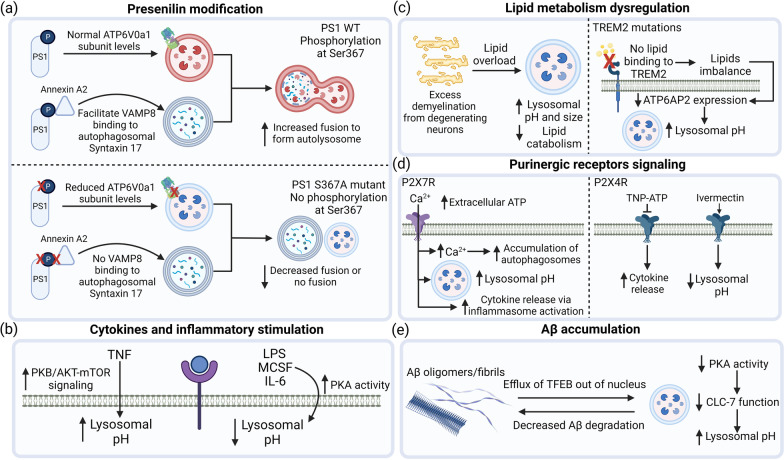Fig. 2.
Factors affecting microglial lysosomal acidification and associated phagocytic and autophagic function. a Presenilin-1 (PS1) deficient in phosphorylation at Ser367 (S367) leads to reduced ATP6V0a1 levels, impairing lysosomal acidification. Furthermore, PS1 S367A reduces binding to Annexin A2 and decreases VAMP8 binding to autophagosomal Syntaxin 17, thereby preventing autophagosome-lysosome fusion, leading to autophagic inhibition. b Cytokine stimulations induce differential effects of lysosomal acidification alterations in microglia. c Lipids such as myelin debris and TREM2 mediated lipid accumulation impair microglial lysosomal acidification through different mechanisms and decrease lipid catabolic activity. d Purinergic receptors signaling regulate lysosomal acidification. Extracellular ATP activate P2X7R, leading to influx of Ca2+, accumulation of autophagosomes, elevation of lysosomal pH as well as increased cytokine release via inflammasome. On the other hand, inhibition of P2X4R by TNP-ATP results in increased cytokine release, while activation of P2X4R by ivermectin improves lysosomal acidification and promotes microglial function. e Accumulation of Aβ protein has been shown to lead to defective lysosomal acidification, potentially due to efflux of TFEB out of nucleus. Similarly, a decrease in PKA activity along with decreased ClC-7 chloride transporter function leads to lysosomal pH elevation, resulting in reduced degradation of Aβ, further driving neurodegeneration. The figure was created with BioRender.com

